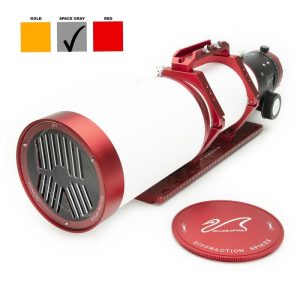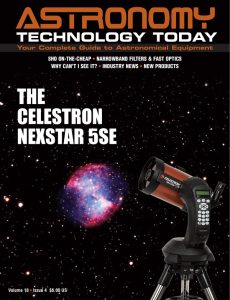Editor’s Note: This news item about the William Optics Astrophotography Contest was written using ChatGPT. With so much content today in the news (and in astro tech surprisingly) being authored through AI, we thought, because of the technical nature of our subject and our audience, that you would find it interesting how an AI approached amateur astronomy’s new products and industry news. This news item, which would normally be two or three paragraphs, is admittedly, quite overblown. It does provide an interesting insight into how AI generates content. Interestingly, it didn’t include the actual prizes, which are quite significant to human astro astronomers. By the way, it took 10 seconds to generate this, where it would take 30 minutes to an hour to write a typical news item. It was fact checked for accuracy which took 10 minutes, a savings of at least 20 to 50 minutes.
Astrophotography, the art of capturing the night sky in all its celestial glory, has been gaining momentum as both a passion and a profession. For astronomy enthusiasts and photographers alike, this fascinating endeavor merges art and science, providing an unparalleled opportunity to explore the cosmos from Earth. Among the prestigious platforms that celebrate this growing community, the William Optics Astrophotography Contest stands out as a hallmark event, showcasing some of the most breathtaking space imagery from around the world.
A Snapshot of the Contest
The William Optics Astrophotography Contest is an annual event organized by William Optics, a well-known manufacturer of high-quality telescopes, binoculars, and accessories for amateur astronomers and astrophotographers. Founded in 1996 by William Yang, the company has built a global reputation for its premium optics, making it a go-to brand for both beginners and seasoned astrophotographers.
The contest is open to participants worldwide, from amateur sky-gazers to professional astrophotographers. The main goal is simple: capture awe-inspiring images of celestial objects such as stars, planets, nebulae, galaxies, and deep-sky phenomena using William Optics gear.
Celebrating Art and Science
What makes the William Optics Astrophotography Contest unique is its blend of technical precision and artistic creativity. Unlike traditional photography contests that focus mainly on aesthetic appeal, astrophotography requires a deep understanding of both photography and astronomy. Contestants must not only capture beautiful images but also deal with technical challenges such as long exposure times, tracking moving objects in space, and processing raw data to reveal the intricate details of celestial bodies.
The contest categories typically reflect the diversity of the cosmos. Some common categories include:
- Deep-Sky Objects: Photos capturing distant galaxies, nebulae, and star clusters.
- Planetary Photography: Stunning shots of planets like Jupiter, Saturn, and Mars.
- Wide-Field Images: Panoramic views of the Milky Way or large sections of the night sky.
- Solar & Lunar Photography: Close-ups of the Sun, Moon, and solar eclipses.
Tools of the Trade
To participate in the contest, photographers are required to use at least one piece of William Optics gear, whether it’s a telescope, guiding scope, or other optics. William Optics has a wide range of popular models, from their iconic RedCat 51 refractor (a favorite among astrophotographers for its portability and versatility) to their ZenithStar series.
Participants often utilize additional equipment like equatorial mounts, which enable precise tracking of celestial objects as they move across the sky, and specialized cameras or modified DSLRs designed for astrophotography.
Judging Criteria
Images submitted to the contest are judged on several criteria, with both technical and artistic aspects taken into consideration. These include:
- Image Composition: The visual appeal of the image, including framing and overall aesthetics.
- Detail and Clarity: How well the photographer captured intricate features such as dust lanes, star formations, or planetary rings.
- Processing Quality: The photographer’s ability to enhance raw images without over-processing or losing natural detail.
- Uniqueness: How innovative or original the subject or perspective is.
 Winners of the contest often receive high-end William Optics gear as prizes, further empowering their future astrophotography endeavors including:
Winners of the contest often receive high-end William Optics gear as prizes, further empowering their future astrophotography endeavors including:
- First Prize: FLT 120 Telescope – Renowned for its exceptional clarity, this telescope is ideal for astrophotographers aiming to elevate their craft.
- Second Prize: FLT 91 Telescope – A powerful tool for deep-space exploration and capturing extraordinary celestial phenomena.
- Third Prize: GT81 Telescope – Perfect for capturing the grandeur of the night sky with precision.
- Fourth Prize: GT71 Telescope – An excellent choice for those who love wide-field astrophotography, offering both versatility and ease of use.
- Fifth Prize: Redcat51 Telescope – A favorite among wide-field astrophotographers, designed to deliver breathtaking images of the night sky.
With total prizes valued at $10,000, this contest not only recognizes the best in astrophotography but also rewards participants with cutting-edge equipment that can help them further their exploration of the cosmos.
The Impact of the Contest
More than just a competition, the William Optics Astrophotography Contest serves as a global platform that brings together a community of astrophotography enthusiasts. It encourages new talent to emerge, inspires others to take up astrophotography, and promotes greater public interest in both photography and astronomy.
Each year, the winning images from the contest often go viral, shared across social media platforms, space-related forums, and photography websites. These images not only highlight the capabilities of modern-day amateur astrophotography but also remind us of the vast beauty and mystery of the universe we live in.
Conclusion
The William Optics Astrophotography Contest has become a beacon for the growing community of astrophotographers, merging the technical mastery of astronomy with the creative artistry of photography. As more people around the world look up at the night sky and capture the wonders above, the contest continues to celebrate the connection between humanity and the cosmos—one stunning photograph at a time.
 And to make it easier for you to get the most extensive news, articles and reviews that are only available in the magazine pages of Astronomy Technology Today, we are offering a 1-year magazine subscription for only $6! Or, for an even better deal, we are offering 2 years for only $9. Click here to get these deals which only will be available for a very limited time. You can also check out a free sample issue here.
And to make it easier for you to get the most extensive news, articles and reviews that are only available in the magazine pages of Astronomy Technology Today, we are offering a 1-year magazine subscription for only $6! Or, for an even better deal, we are offering 2 years for only $9. Click here to get these deals which only will be available for a very limited time. You can also check out a free sample issue here.

